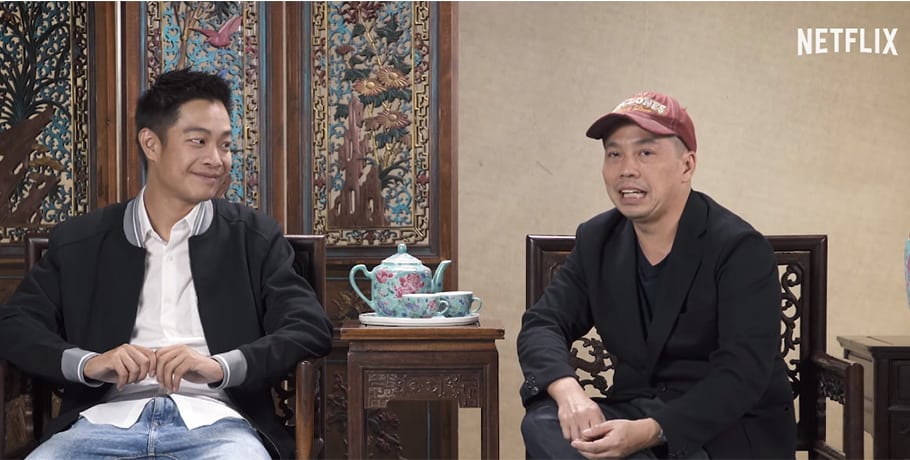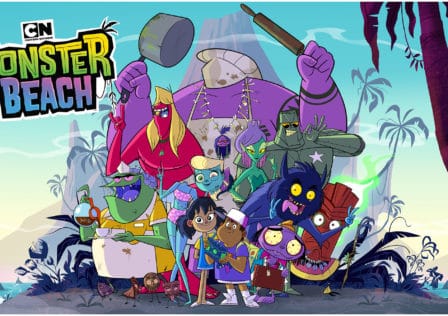There is no simple way to classify The Ghost Bride. Produced in Malaysia, Netflix’s first Chinese language original series follows a girl being forced to marry the deceased heir of a rich family and becomes embroiled in the sinister cause of his death.
Adapted from a New York Times bestseller of the same name, The Ghost Bride is probably best described as a supernatural horror period murder mystery romantic comedy with the trappings of a K-drama (though Netflix calls it the “Eastern version of Twilight“).
None of those genres are familiar to Quek Shio Chuan, co-director of The Ghost Bride. And that’s just the way he likes it.
It has been a little over a year since Quek’s first feature-length debut, Guang, became a sleeper hit in Malaysia. Recently, it bagged the Best Feature Film award at the Asia Pacific Film Festival – the first Malaysian movie to win the honour.
Guang tells the hero’s journey of an autistic man and his complicated relationship with his ‘guardian’ – his younger brother (our review here). While the success launched Quek’s filmmaking fame, it also built a cage of sorts for him.
In an interview with DeconRecon, Quek explains that, after Guang, the filmmaking opportunities offered to him were often emotional dramas involving a differently-abled or mentally-challenged character.
“[As a director] you tend to get ‘zoned’ into one style,” he says.
This, Quek notes, is also true for commercials – his main bread and butter. But whether it is making films or advertisements, he tries not to tell the same story twice.
When the chance to direct The Ghost Bride came along, Quek jumped at it because the show would put him well out of his element.
“From making a reality-based movie drawing from my own life experiences about two brothers grappling with the serious issue of autism, I can now make a period supernatural fantasy love story, which involves ghosts… to me, this is the challenge that I look for as a filmmaker, and it excites me to participate in something so different,” he enthuses.
Sharing the directing credit with Quek is Ho Yuhang, the prolific Malaysian director who is no stranger to horror (he directed an episode for HBO Asia’s horror anthology series, Folklore), comedy (his television commercials are known to tickle), and dramas (his sobering storytelling for Trespassed, Sanctuary and At the End of Daybreak has achieved international acclaim).
But romance? That was uncharted filmmaking territory for him. This only made him more eager to take up The Ghost Bride.
“At the end of the day, it can be a musical, a horror, a police procedural story – it’s still talking about human emotions… their psychological states, what makes them tick, why they do what they do. These are all basic questions, no matter the kind of films,” Ho tells DeconRecon.
A union like no other
Steeped in mythical beliefs and UST, The Ghost Bride certainly provides rich fodder to explore the inner plumbing of the human condition. The six-episode miniseries is set in 1890s Malacca, the bustling trading port of the Malay peninsula. Pan Li Lan (Huang Pei Jia), a young girl rocking Nyonya Kebaya while being doted on by her widowed father (Jordan Voon) and house helpers, leads a carefree life.
Li Lan (right) dreams of seeing the world, while her maid/mother figure (Susan Leong) urges her to settle down for marriage
The good times come crashing to an end, as good times do, when she receives a marriage proposal from an influential family to wed their recently-dead son. While ‘ghost weddings’ like this have been a longstanding Chinese tradition, Li Lan is understandably aghast at the request.
But, as her family fall on hard times, Li Lan agrees to the marriage. Little did she expect that her ‘fiancé’ (Kuang Tian) from the netherworld would enlist her to investigate his mysterious death, leading her to cross paths with a cheeky heavenly guard (Kang Jen Wu) working on the same case.
The setting of early-19th-Century Malacca adds colour to this foreboding fairy tale. The Malaysian state is a land of diversity – intermarriages between immigrants from China and locals from as early as the 16th Century led to descendants who practice the cultures of both. The men are known as Baba and the women Nyonya; Lilan herself is mostly dressed in the Nyonya traditional dresses. Waves of colonists from Portugal, the Netherlands, and England created an even more intense intermingling of cultures.
Set designers of The Ghost Bride recreated the marketplaces of Colonial Malacca
While some colonial buildings still stand in Malacca, the growing commercialisation in the heritage sites meant that it was difficult to close the streets for production. Plus, the odd H&Ms and McDonalds were getting into the shots. Outdoor sets had to be built in Johor, a state further to the south, while the interior scenes were shot in well-preserved heritage sites in Penang, Ipoh and Taiping.
This means that both directors had to be on set at all times to shoot their respective scenes at a single location before moving to the next. Thus, even though Quek is credited for the first three episodes and Ho is credited for the last three, both clarify that they were not working in silos, but often consulted and collaborated with each other on set.
Director Quek Shio Chuan on set
According to Ho, film directors are not known to play well together. But bromance blossomed between Ho and Quek anyway, if the uproarious laughter they shared during interviews with DeconRecon was anything to go by. Sometimes, they finished each other’s sentences. Other times, both simply talked at once but managed to be in sync with their points.
After all, Quek and Ho were “together all the time”, says showrunner Zainir Aminullah.
“Like we’re married. Very scary,” says Ho. Another eruption of laughter raised the roof.
Despite the bromantic spark between them, both filmmakers are vastly different in their directorial style. The cast of The Ghost Bride tells of a Yin-and-Yang-like dynamic between Quek and Ho. The former allowed them a freer hand in interpreting the characters and preferred to adapt to the rhythm and flow of a scene on set. The latter was a stickler to his vision for a scene, often pushing the actors to achieve it.
From left: Showrunner Zainir Aminullah, Director Quek Shio Chuan, Director Ho Yuhang
Their difference is their strength, notes Zainir, CEO of Revolution Media that partnered with Netflix to produce The Ghost Bride. “You do want the diversity [in direction], you do want the unique and distinct colours that each of these directors bring, and I think we got it from both of them.”
“We’ve never seen anything like this”
Beyond the set, Quek and Ho brought their distinct flavours to the creative table as well, tossing ideas and concepts back and forth with the producers before filmmaking even began.
Both directors found this refreshing. According to Ho, directors brought in to work on a show are often expected to be “yes-men robots” who just make what they are told. But, in filming The Ghost Bride, they were able to experiment on the fly to receptive showrunners.
“We got huge flexibility and freedom from Netflix, which is rare when you work with a huge platform or studio,” Zainir tells DeconRecon. “The flexibility and freedom we got became a virtuous loop, because we were able to escalate a lot of ideas and input, and it became an iterative process in which we were all thinking what’s best for the series, rather than just what’s on the [script] pages.”
Director Ho Yuhang (left) on set with Kuang Tian (right), who plays the ‘ghost husband’ Lim Tian Ching
Much fun was had in the liberty to create. Yet Zainir is kept sober by the pressure to live up to the standards of Netflix, which has worked with legendary directors like Alfonso Quaron and Martin Scorsese. The streaming behemoth also swept more Oscar nominations than any other studios this year.
The showrunner recalls his sleepless night after learning that he scored The Ghost Bride project. The anxiety of producing a show that has to “sit comfortably” next to globally-beloved Netflix Originals like Money Heist, Narcos, and The Witcher had set in fast.
“Netflix is a unique platform because what you produce will be immediately accessible to 190 markets and about 160 million subscribers worldwide,” says Zainir. This drove him and the directors to keep pushing the envelope – from set design to characterisation – in the strife to “make everything bigger and more interesting”.
The fantastical elements of The Ghost Bride brought to life with CG special effects
Movie magic helped. Computer-generated (CG) special effects and backgrounds were employed for this period fantasy romp, which created some awkward firsts for the directors used to working with shoestring budgets.
Ho, who has never relied much on expensive CG effects beyond digitally erasing the safety harness on actors, called The Ghost Bride “a fascinating experience”. He points out that heavily-CG scenes require extensive planning to ensure seamless integration of reality and digital wizardry.
“Real story: we walked into a set and it was just four green walls!” he exclaims, referring to the green screen backdrops that would later be superimposed with visual effects. “Imagine working with these really good actors acting as if there is something there! That was very new to me.”
But what truly boggled the minds of Zainir, Quek, and Ho was how quickly Netflix kicked into high gear for the marketing of The Ghost Bride.
The three remember their first meeting with a room full of Netflix executives – half of whom were marketing folks.
“When we listened to their marketing plan, it was so impressive and fully-developed, and the marketing team was involved right from the start. It’s almost like a different production that goes along with our production,” says Quek, adding that this is a departure from the usual local practice of making a film first and worrying about promotions later.
Zainir chimes in, “We’ve never seen anything like this before.”
idk ’bout you but this wedding season for the ghost bride boutta be lit. pic.twitter.com/QzOVoODYw1
— Netflix Malaysia (@NetflixMY) January 17, 2020
In 2017, the business daily The Malaysian Reserve quoted the National Film Development Corp Malaysia (Finas) board member, Zahrin Aris, that local films are lagging behind in promotional and marketing strategies.
Both Ho and Quek believe the zeal and investment into marketing is something that the Malaysian entertainment industry “should strive to achieve”.
“This is basically a tech company mentality,” Ho points out. “You don’t put out something that you cannot sell. If you want to make something, you need to know how to get it out first.”
Even if that thing is a supernatural horror period murder mystery romantic comedy.
The Ghost Bride premieres on Netflix tomorrow, 23 Jan 2020.
Also published on Medium.

writes about pop culture with the suspicion that it is actually writing her.


